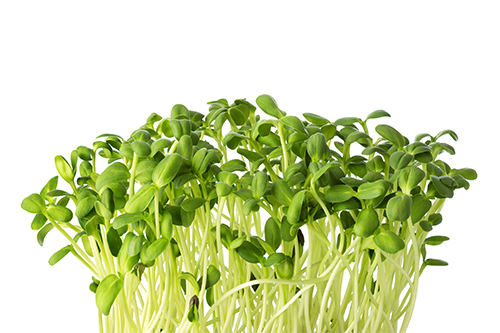Our Greens
Microgreens That Taste as Good as They Look
We are devoted to growing delicious microgreens that are easy and fun to enjoy. Each microgreen has its own unique flavor. Whether used alone or mixed with more traditional herbs, our microgreens are sure to impress. They contain an array of vitamins and mineral that are vital to your health. We hope people in our communities will join us on this journey into tasty and healthy eating.
Seasonal Offerings

Sunflower
crunchy and succulent texture, savory, nutty, and slightly sweet flavor
Nutrients: Protein, Calcium, Iron, Potassium, Phosphorus, Magnesium, Vitamin A, C, B-Complex
Sunflower microgreens are an excellent source of complete protein. They’re a great way to repair muscle tissue, help to keep gut bacteria healthy, and support our immune system. Read more…
Buckwheat microgreens are gluten-free. They are full of antioxidants, protein, and various minerals. Buckwheat microgreens can help blood sugar control, lower LDL cholesterol (bad cholesterol that leads to heart blockages), and support heart health. Read more…

Buckwheat
soft texture, citrus-like flavor with tarty and tangy undertones
Nutrients: Vitamins B, C, and K, folic acid, and fiber
Standard Offerings

Salad Mix
crunchy texture, nutty, fresh brassica flavors, mild spice
Contains: Broccoli, Kale, Kohlrabi, Arugula & Red Cabbage.
Nutrients: Vitamins B, C, and K, potassium, iron, thiamine, magnesium, phosphorus, and fiber

Spicy Salad Mix
crunchy, nutty, fresh, and a nice spicy kick
Contains: Broccoli, Kale, Kohlrabi, Arugula, Red Cabbage & Mustard for an extra kick.
Nutrients: Vitamins K, E, and C, calcium, iron, and beta-carotenes

Kale
crunchy texture, a strong green kale flavor, nutty and rich
Nutrients: Vitamins A, C, and K, antioxidants, fiber, iron, and copper

Broccoli
soft texture, mild broccoli flavor
Nutrients: Vitamins A and C, calcium, iron, and phosphorus

Cabbage
soft texture, strong cabbage and broccoli flavor
Nutrients: Vitamins C, A, and E, beta-carotenes, potassium, and iron

Pea
crunchy and succulent texture, sweet, fresh pea flavor
Nutrients: Vitamins C, E, and A, zinc, catechin, and epicatechin
FAQ
How should I choose microgreens for myself and my family?
There is no definition for the best microgreen. It all depends on your palate and taste preferences. Microgreens contain the same taste profile and allergens as the mature vegetables. They have distinct flavors ranging from spicy, nutty, and bitter to flavors that are mild or sweet. Microgreens can be a great way to introduce kids to new vegetables! We recommend starting with sweet and mild microgreens, such as peas and broccoli.
How should I wash microgreens?
Only wash your microgreens when you are ready to eat them. Place them in a bowl, rinse gently with room temperature water, drain and place on paper towel or clean kitchen towel to gently dry your microgreens. You can also put them in your salad spinner as long as the spinner’s holes are not too large.
What are the best ways to store microgreens?
Keeping your microgreens cool and dry is the key to making sure they stay fresh. Heat and excess moisture can turn them mushy right away, so keep them refrigerated in the plastic container. You can add a paper towel inside the plastic container to absorb excess moisture to keep it fresher longer. Only wash your microgreens when you are ready to eat them. You can also dehydrate them: dehydrated microgreens can be eaten as crunchy snacks, similar to kale chips, or ground into powder and added to smoothies, soups, or shakes. Check out how Microgreens Can Be Dehydrated.
Can I freeze microgreens?
Since microgreens are best eaten fresh, we don’t recommend it. The cold temperature will break down the cellular structures in the green. If you must freeze your microgreens, we recommend using them in smoothies to maintain their nutrition as much as possible.
Still have more questions?
We’re a friendly bunch. Connect with us and share your thoughts.
We’re on a mission to inspire sustainable real food.
Join the movement and become a part of the community and start creating extraordinary things.

